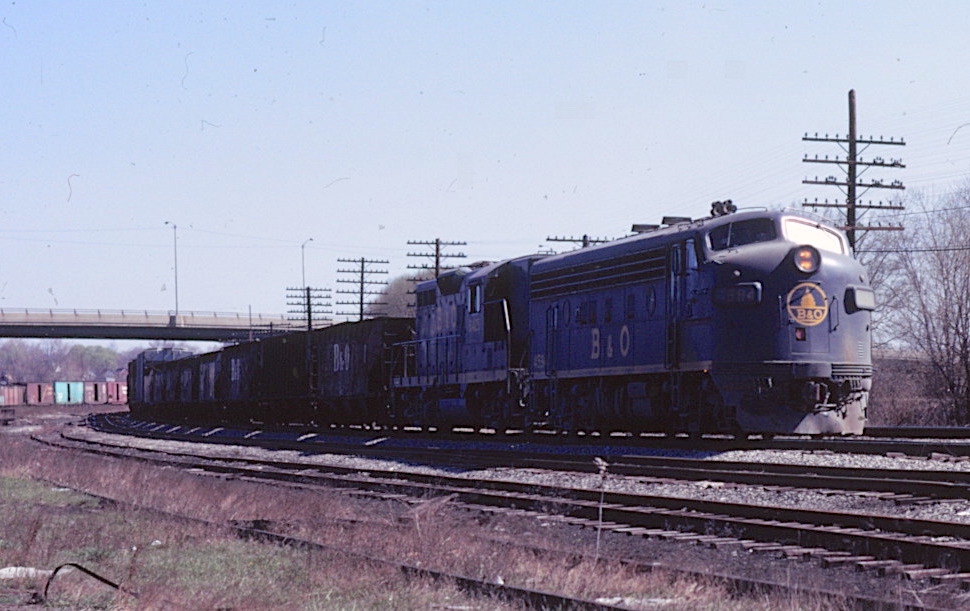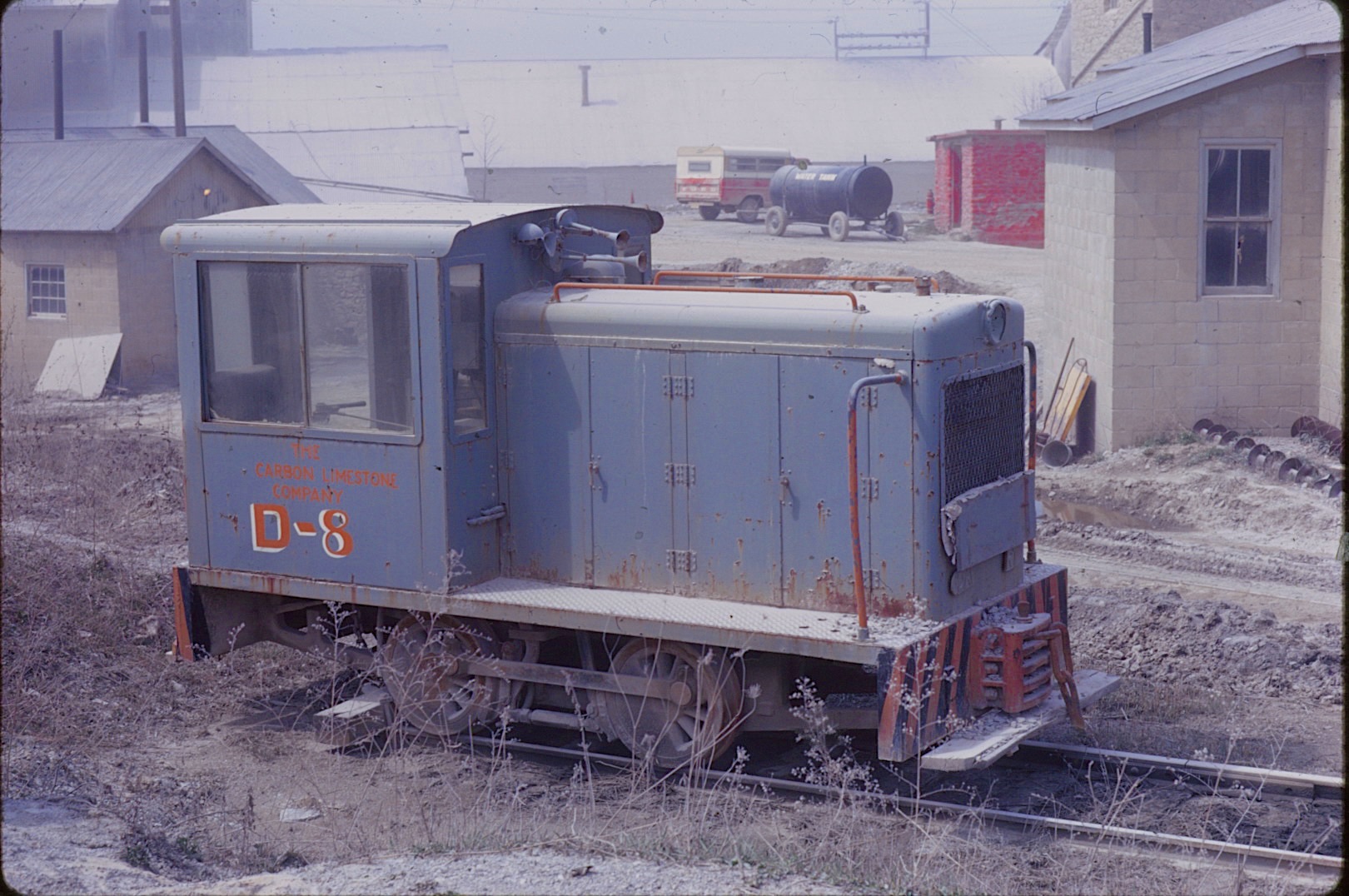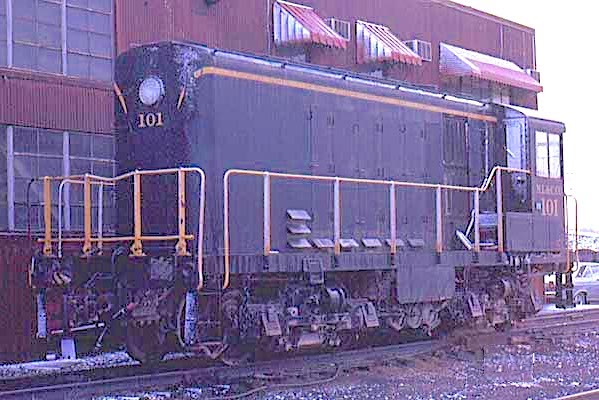Baldwins, Critters & Other Surprises |
|
|---|---|
 A friendly B&LE hostler pulls Precision Engineering F7A #717 out of the Greenville, Pennsylvania diesel shop on 23 April 1971 |
|
Highlighted here is an overview of an April 1971 trip around Lake Erie;
the three-day blitz included a mix of mainline, short-line and industrial railroading. Planning
for the trip began in January with a letter writing campaign to a few specific targets requesting
permission to photograph: (1) F-units at Pittsburgh & Conneaut Docks (2) an eclectic critter
roster at Carbon Limestone, and (3) the new SD38 power on the Bessemer & Lake Erie. Everything in
between would be on basis of "hit-or-miss."
On Friday the 23th, our camera-toting foursome (Ray Sabo, Denny Custer, Lloyd Judd and myself) departed Detroit at 0500 dark, with four hours allotted to reach the first appointment at Babock & Wilcox in Barberton, Ohio. The only delays en-route were an unscheduled pause to photograph an idled Akron & Barberton Belt S-12 #27 (a Baldwin S-12) and a panic stop in Akron to shoot a westbound Baltimore & Ohio freight with F7A and GP9 leaders. | |
  | |
Babock & Wilcox which was a last-minute addition to our target list indicated that they
would be happy to host a visit. In addition to a 35-ton GE end-cab (c/n 33920, b/d 6/1960),
we were treated to a one of only five-ever built 50 tonners produced by BLH/Whitcomb (c/n 76022)
in 1954; both units were already in-position and waiting. Five years later the model S3 Whitcomb
would don red/white/blue to celebrate the Bicentennial. After carding the stop as a "win," the
hood ornament on Ray's "Sabo-mobile" (a 1968 Mercury wagon) was pointed eastward with only clear
skies on the horizon; the schedule still dictated a degree of tight running. |
 |
By late-morning, we reached the Carbon Limestone Company located in Lowellville, Ohio. A
colorful Civil War Era-looking 2-4-0 (actually built as a 0-4-0 in 1942) stood at the entrance
and beckoned us forward. The company's huge quarry operation straddled both sides of the Ohio /
Pennsylvania state line. When it came to old, rare and obscure diesels, GLC had its share, a
few might have been considered museum pieces. Additionally, there were a pair of 0-4-0Ts that
had been sidelined years prior. |
|
  | |
Founded during the 1880s, the limestone supplier ran both narrow and standard gauge critters
in day-to-day operation. Some of their locomotives had been World War II military surplus, such
as GE 60-ton off-center cab #D-11 pictured here built in 10/1941 (ex-US Army 7501 c/n 13142,
b/d 10/1941) --[left photo]. Whitcomb-built #D-10 had also served a stint in the military
(ex-US Army 8430 c/n 60436, b/d 1944) -- [ right photo]. GLC's Narrow-gauge operation was the
domain of 25-Ton Whitcombs, 10-ton Davenport (c/n 3104 b/d 7/1948) and a couple of four-wheel
gas-mechanical Plymouths.
| |
 |
 |
|
Carbon Limestone was the last appointment of the day which gave us ample time to explore
the Youngstown area, as well as checking-out a couple of steel companies in nearby western
Pennsylvania. A stop at the Youngstown & Southern's small yard netted one of the short-line's
two SW7s (#70 - EMD c/n 13019, b/d 10/1950). Youngstown Sheet & Tube's large manufacturing
complex in Campbell, Ohio was the next objective; we had envisioned a small array of Alco and
Baldwin switchers moving methodically around the industrial site. However, reports of a
declining steel industry had not been an exaggeration -- only one YS&T Alco S2 was spotted.
The final stop in Ohio was the Erie-Lackawanna Brier Hill Yard; it provided the first real
surprise of the trip. Baldwin-built Erie #617 S-12 (c/n 74875, b/d 2/1951), which still wore
an original 20-year-old Erie Railroad livery, stood basking in the sunshine. Our time
had been well spent. |
 |
Near-by in the Keystone state, our attention was grabbed by a pair of GE 80-ton critters at
Shenango Steel (c/n 30933, b/d 6/51) and Sharon Steel (c/n 31337, b/d 4/52). Feeling satisfied
and optimistic, we charged north in search of some action on the Bessemer & Lake Erie. |
 |
|
B&LE SD7 #803 and SD9 #821 were working the yard when we arrived in Greenville; it became
apparent that most of the iron ore carrying trains, including the desired SD38s, were elsewhere
on the system. The next objetive then was the Greenville diesel shop; the sight of two 6-axle
Chesapeake & Ohio Baldwins made us quickly forget about the SD38s. The C&O-owned AS-616s were
on short-term lease while the Bessemer waited on the tentative arrival of new SD38ACs in June.
The aging BLWs were the second surprise of trip; one more was waiting behind shop doors
-- it was Precision Engineering F7A #717 (photo at top). Luckily, we found a friendly hostler
who pulled the yellow PECo engine into the day's waning light. In an earlier life, the leased
F-unit had worked these very same rails.
| |
 
| |
|
A few miles north of Greenville, we encountered our first and only B&LE action of the
trip. A four-unit southbound ore drag was stopped for a red board. Two Bessemer SD9s
(#826/828) had the point position along with a yellow F7A #70C (ex-Chicaago & North Western
#234) and F3B #30B (C&NW #308) tandem from the Precision lease fleet. It was later learned that
the railroad had leased several of these aging F7As and F7Bs; many of them had once carried
the B&LE banner.
The first day of the trip ended in Conneaut, Ohio beneath a star-filled sky, with no reason to suspect our luck would end. |
 |
|
Saturday morning greeted us with a thin layer of snow and an overcast
sky; the snow quickly smelted but the overcast stayed with us for most of day. There was time
to kill before the appointment at Pittsburgh and Conneaut Dock, so we found a quiet spot just
west of town on the Penn Central and let the action come to us. Conditions were not optimal,
but what the heck!
Interestingly the three Penn Central trains that came our way were all led by GE U-boats;
there must have been a surplus of four-axle GEs in Buffalo and the foreman of engines wanted
to move them. |
 |
|
Armed with photo permits, we got a behind-the-scenes look at the Pittsburgh & Conneaut
Dock's rail operation, and there were only three stipulations, "Don't cross the tracks, don't
interfere with operations and stay with your escort at all times."
A pair of remote-controlled F-units were working the yard; they been purchased from the B&LE in 1968. P&C Dock F7A #1 and F7B #2 were originally B&LE #715A and 715B (c/n 16598 and 16598) respectively. Right on queue, a break in the overcast appeared and showered P&C Dock #1 and stablemate with sunshine; the gleeful moment was short-lived as the clouds reclaimed the sky. Luckily for us, B&LE DRS 66-1500 #405 (BLW c/n 74934 b/d 7/50) was also being used; it had only ever known one master. According to our guide, the aging Baldwin was a favorite of crews because of its ability to dig-in and move tonage. During the tour of P&C facilities, another visitor from Michigan was spotted; it was Alco HH1000 #101 on leave from its normal duties at Michigan Limestone in the Upper Peninsula. By the way, no industrial site is complete without at least one small critter; the honor in Conneaut belonged to #304, a GE 35-tonner (c/n 12989 b/d 2/41). |
|
  | |
  | |
|
In-spite of a mostly overcast sky, the morning of day 2 had been a success; but the
clock was ticking and Erie Pennsylvania (GE), Buffalo, New York and Toronto still had to be
explored during the next thirty hours. That part of the trip will be covered next month. |
|
|
Text and photos by R. Craig Rutherford
| |